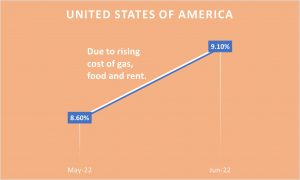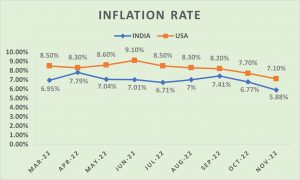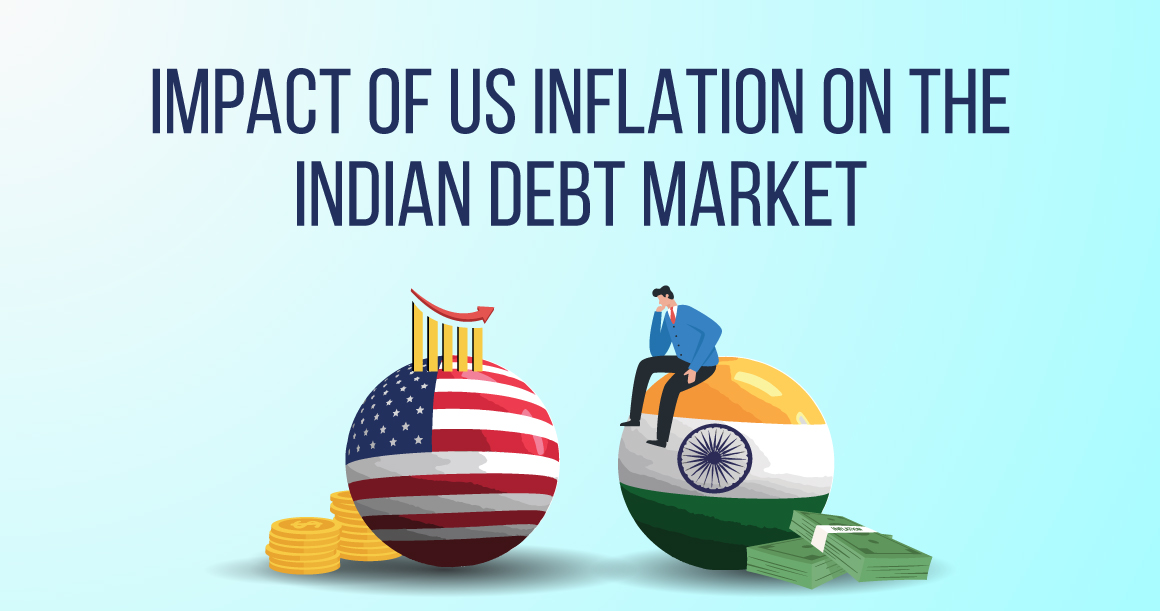As of September 2, 2022, India has surpassed its former colonial ruler, the United Kingdom, to become the fifth-largest economy in the world. According to IMF forecasts, India is also expected to overtake other countries and become the third-largest economy by 2029. India being the second most important driver of global growth in 2022 after China, it contributes about 14% towards global growth. The US serves as the guiding force in the world economy, standing on the topmost levels in all the parameters. Hence it becomes very important to analyze the effect of recent US inflation on the country. Before we move ahead in analyzing the effect of US inflation, let’s understand what exactly inflation is.
What is Inflation?
An economy experiences inflation when the cost of goods and services rises, decreasing the buying power of money. When necessary, governments use monetary policies to control inflation. In the case of rising inflation, a government would use monetary policies to restrict the amount of money available in the economy by raising interest rates, which would also diminish the market value of debt instruments and increase yield to maturity (YTM).
What caused US Inflation?
Due to global supply chain disruptions and fiscal stimulus from governments early in the coronavirus pandemic, inflation in the US has risen to a 41-year high of 9.1% in June. According to analysts in India, this may prompt the US Federal Reserve to raise interest rates more aggressively, which will then cause more foreign capital to flow out of India and hurt the Indian rupee and stock markets.

Fig 1: Reason behind the movement of the Inflation rate in the USA
The above graph represents the largest 12-month increase since 1981 in consumer price inflation in the United States. Prices increased by a significant 1.3% monthly from May to June, following an increase of 1% from April to May.
US Federal Reserve System or FED is a group of officials who controls the US government’s central banking system, similar to what the Reserve bank of India does for India.

Fig 2: Inflation in USA and India
Why are the signals from the Fed important to the rest of the countries?
The US Fed conducts monetary policy similar to other central banks, such as the Reserve Bank of India, and largely affects employment and inflation by employing tools to manage credit availability and costs in the economy. The following diagram summarizes the cascading effects of US Fed policy over other countries.

Quantitative easing, often known as the bond-buying program, was implemented in 2020 as an extraordinary measure to assist the financial markets and economy in reducing the effects of the pandemic. The goal of quantitative easing is to increase economic activity by injecting money into the economy through the purchase of specified amounts of government bonds or other financial assets by central banks.
For instance, during Covid-19, a total of $6 trillion was infused into the economy to support the households in the US. It was also used during the global financial crisis.

As a result, today, the US is facing inflation affecting the economy of other countries as well.
As an immediate reaction to it, RBI has carried out a cumulative rate hike of 140 basis points since May (One basis point is one hundredth of a percentage point).

Fig 1: Inflation and Repo rate in India
While CPI inflation dipped slightly to 6.71% in July, it rose once more in the three months that followed, hitting 6.77%. This represents the 10th consecutive month that CPI data has exceeded the RBI-set upper ceiling of 6%. The RBI is anticipated to increase the repo rate by 25 basis points in the upcoming months as long as the inflation rate remains below its tolerance level.
How does Inflation Affect Bond price?
What are the impacts of US Inflation on the Indian Financial System?
Understandably, there are several impacts of increasing inflation IN the US on a few areas In India? In this section, we will briefly discuss 4 areas – the Indian Economic as a whole, Debt Market, Indian currency, and Foreign Investors
Indian Economy
For emerging markets like India, a problem with high inflation has always existed. After the Covid-19 shock and the war between Russia and Ukraine, inflation has affected every economy. The main effect of high US inflation is the depreciation of an economy’s currency rate. Thus demonstrating the US dollar’s superiority. Dollar assets, the safest in the world, will provide better returns when policy rates rise. With the interest rate disparity closing, this lessens the appeal of assets from emerging markets. Elevated inflation is a persistent issue for an expanding market like India since demand frequently exceeds the supply of goods and services. However, exogenous shocks have worsened, particularly the rise in oil prices.
The central bank of India increased its benchmark policy rate by 90 basis points (bps). This falls short of the 150 bps increase by the Fed. The Federal Reserve is projected to raise rates more frequently in the future than the Reserve Bank of India (RBI).

Debt Market
Global markets are being affected by the US economy’s rising inflation, suggesting that interest rates will rise and make the US market more attractive to overseas investors. The primary areas where the Indian debt market is bearing the brunt of rising inflation in the U.S. are a further reduction in investment by foreign portfolio investors (FPIs), an outflow of money from the market as investors would now have the option to earn higher returns by investing in the U.S. market.

Maturing Indian Debt market refers to growing FED interest rates having little impact on the maturing Indian debt market, according to this term.
Consequently, the impact of US inflation on the Indian debt market cannot be considered of much relevance as it doesn’t affect it at a higher intensity.
Indian Rupee
Every macroeconomic indicator of the US has significance for the rest of the globe due to the dollar’s status as a reserve currency, and India is no different. High-interest rates in the US due to tight Fed policy will result in a depreciation of the US dollar against the Indian rupee.
As stated in one of the articles by News18, “the depreciating currency for India generates two policy responses — market intervention through dollar sales to manage currency volatility; and management of domestic liquidity and domestic interest rates to control inflation on account of imports”.
Over the past few months, the Indian rupee has fallen to a record low against the US dollar of Rs 82.73 as on 13 December 2022. This pressure developed as a result of FPIs withdrawing money from Indian equities.
For instance, if India holds a reserve of $100 bn, it would be around for Rs. 8,273 bn approximately. Therefore making $1 = Rs. 82.73. If the price of dollars increased, then the FPI would start removing money from the economy. If they extract or pull out $ 5 bn, then the reserves would be $ 95 bn, but the total rupee reserve would remain the same i.e. Rs. 8,273 bn. Hence it will make the dollar more expensive, (8273/95= 87.08).
Foreign Investor
As a result of the Fed raising its policy rates, the interest rate spread between the two nations narrows, making nations like India less desirable for currency carry trades.
A high rate signal from the Fed would also mean that the US economy would receive less of an impetus for growth, which might be further more bad news for global economic expansion, particularly as China struggles to recover from a real estate crisis.
Since October 2021, foreign investors have been withdrawing funds from the Indian markets. So far, foreign investors have sold Rs 2.21 lakh cr worth of stock, whereas they have just taken out Rs. 4000 cr from the debt market, which is a very small amount as compared with the stock market. This proves that the Indian debt market has surpassed the level of dependence on the US or any other market.
In the year before this, 2008, records showed that they had withdrawn a net amount of Rs 52,987 crore.
Summary
The goal of the US central bank is to manage inflation at or below 2%. After the most recent inflation figures, a US rate increase may further restrict FPI flows and corporate dollar-raising plans, which increases the possibility that the rupee will depreciate.
The combination of aggressive rate increases by the US and the possibility of a recession is bad for the global economy, especially the Indian economy.
- If the FED keeps rising interest rates and RBI is unable to keep up, Indian dollar reserves could be adversely impacted. Since it would make the rupee more expensive, trading would be challenging.
- Due to recent increases made by the RBI to create a sizable disparity between Indian and US debt instruments, the Indian debt markets are rapidly maturing. Therefore making it appealing for foreign investors.
- The US has significance in every country across the world, as the dollar serves as a reserve currency. Therefore with tight US FED policies, the rupee is depreciating against the US dollar, as the forex reserves are going down in india.
- Foreign investors play a very important role in the world’s economy as they help maintain the dollar reserves of the country. With the increasing fed rate, Indian debt securities become less desirable for foreign investors. Whereas even after the increase in the fed rate, the debt markets are performing well, proving that they have surpassed such effects.
However, compared to other nations, the total impact on the Indian debt market would not be huge.







